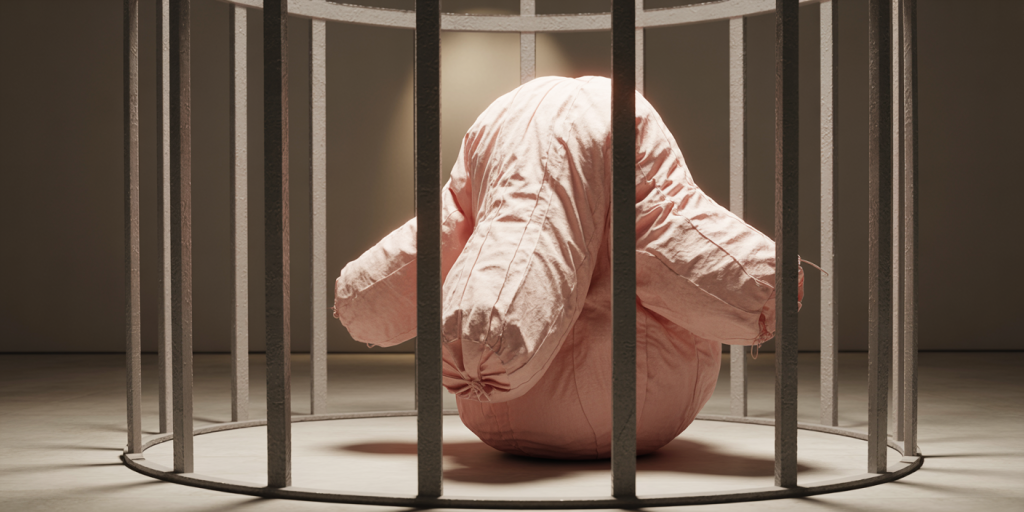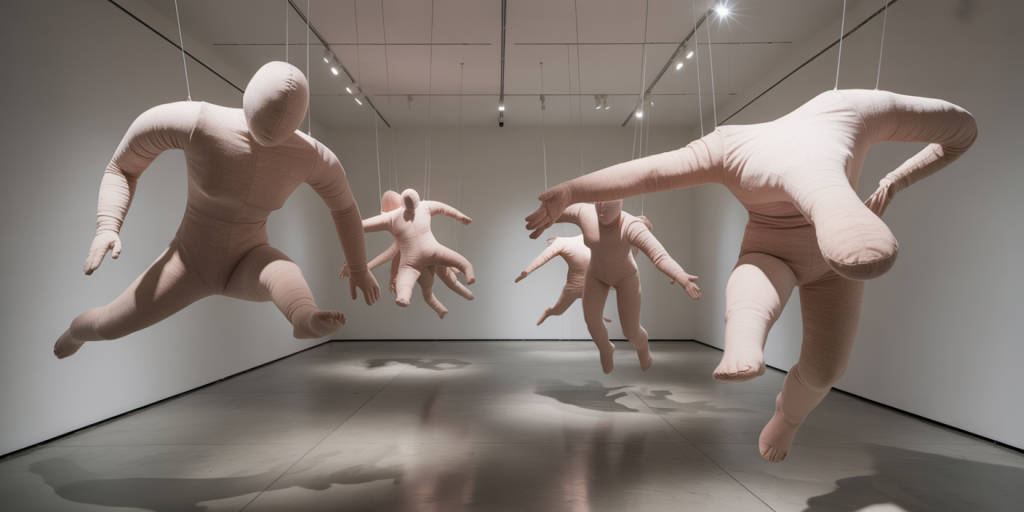Louise Bourgeois and the Monsters that Lived in Her Basement of Affection
In the dim corners of memory, where love coils around trauma and tenderness dances with terror, Louise Bourgeois carved her truths. Her art is not an offering—it is an excavation, a descent into a psychic cellar where familial whispers grow claws, and affection drips with ambivalence. Within this subterranean vault, monsters stir—sculptural confessions that ache, seduce, recoil, and linger.
One does not simply observe Bourgeois’s work; one confesses beside it. The forms she births are not objects, but specters—half-healed wounds, stitched from silk and steel, fur and bone. Her monsters are not to be feared, but to be felt. They are the incarnations of inner life—maternal and monstrous, fragile and unflinching. They ask not to be understood but to be remembered.
Summary
- The Red Thread of Memory
- Threads That Bleed from the Skin
- The Embrace of the Spider
- Flesh Bound in Fabric
- Wombs as Altars
- The Ladders That Lead Nowhere
- Sculptures that Cry in Silence
- Pink as a Color of Terror
- Cage as Womb, Cage as Tomb
- The Eyes that Never Close
- Love Carved in Latex
- Sewn Secrets of the Cellar
- When Needles Replace Words
- Softness with Teeth
- Architectural Organs
- The House that Breathed Grief
- The Duality of the Matriarch
- The Body Torn into Rooms
- Silk Ghosts and Bone Memories
- Where Trauma Finds Shelter
The Red Thread of Memory
Red appears again and again in Bourgeois’s oeuvre—not as a symbol of danger, but of umbilical intimacy. The red thread is the line of memory itself: taut, unraveling, stitched across generations like wounds that refuse to close.
This thread connects and confines. It binds her sculptures to her past and the viewer to their own. Through it, she weaves not stories, but scars.
Threads That Bleed from the Skin
In Bourgeois’s textile pieces, thread is not a tool—it is a voice. Her sewn forms do not simply replicate the body; they reconstruct its pain. Flesh becomes fabric, and stitching becomes a form of articulation.
The skin bleeds in seams. The act of sewing becomes an act of remembering. Her hands do not mend—they reanimate.

The Embrace of the Spider
Perhaps her most iconic figure, the spider is not a predator—it is a mother. “Maman,” standing tall in steel, both protects and frightens. Its legs are poised like fingers or spears. Its belly, bulbous, contains marble eggs—silent, inert, eternal.
Here, maternal love is colossal and complicated. It shelters, but it overshadows. It spins safety and suffocation in the same breath. The spider is not a monster—it is a mirror of motherhood.
Flesh Bound in Fabric
Her anthropomorphic forms—headless, sexless, but aching with emotion—are not about the body, but about embodiment. She wraps trauma in softness, sews tenderness into terror. Her stuffed torsos and knotted limbs pulse with remembered touch.
The fabrics are not beautiful. They are stained, faded, frayed. These are not garments—they are skins. And inside them, longing pulses like a second heart.
Wombs as Altars
In Bourgeois’s world, the womb is not just the beginning—it is the temple. Repeated forms of swollen abdomens, birthing tunnels, and protective chambers appear in sculptures and drawings alike.
They are holy and haunted. In them lives the tension between creation and confinement. The womb births life but also contains the weight of loss.
The Ladders That Lead Nowhere
Ladders populate her Cell installations—wooden, skeletal, leaning toward nothing. They offer the promise of ascent, the illusion of escape. But they end in air, against bars, or vanish in shadow.
These ladders are dreams with no destination. They are the artist’s way of showing how hope can become habit, how healing is often unreachable—but still desired.
Sculptures that Cry in Silence
Some of Bourgeois’s most powerful sculptures do not move, but they weep. Eyes, breasts, and genitals are replicated in forms that seem to tremble. They hang, twist, or stand in sterile cages.
The silence of these pieces is thunderous. They do not speak—but they remember. They remember every touch, every trespass, every unspoken word.
Pink as a Color of Terror
Pink is a color we associate with innocence, femininity, softness. Bourgeois weaponizes it. Her pink fabric figures bleed from their seams. They droop, sag, collapse inward.
In her hands, pink is not tender—it is terrifying. It mocks the myth of feminine fragility, exposing the horror stitched into every pretty thing.
Cage as Womb, Cage as Tomb
Her series of Cells reveals the poetic paradox of enclosure. These wire chambers contain furniture, mirrors, fabric organs, glass jars. Each one is a room within a mind—a diary written in three dimensions.
The cage is simultaneously prison and protection. It contains what cannot be held, and in doing so, gives shape to the formless.

The Eyes that Never Close
Bourgeois often sculpted eyes—watchful, lidless, fixed in place. These eyes do not observe the world; they haunt it. They are the eyes of memory, of maternal surveillance, of inner self-scrutiny.
Each eye is a relic of pain. They do not accuse—but they do not forget. To look at them is to feel seen by something ancient and wounded.
Love Carved in Latex
In some works, she used latex—flesh-like, pliable, perishable. This was not an aesthetic choice, but an emotional one. Latex decays. It yellows, cracks. It ages with the viewer.
Through this material, love is not eternal. It is vulnerable, temporal. And that temporality makes it sacred.
Sewn Secrets of the Cellar
Her sewing is confessional. In the stitched line, we read the unspoken. In the padded shapes, we feel what was never said aloud. These are not dolls. They are diaries.
The cellar, for Bourgeois, is not just physical—it is psychic. And through her thread, she lowers us into its dark, warm, sorrowful depths.
When Needles Replace Words
Bourgeois was not always able to express her truths in language. The needle became her tongue. Each stitch said what could not be said aloud—rage, grief, guilt, desire.
There is no punctuation in her threadwork—only pulse. The art does not end in a conclusion. It continues like breath, like pain, like memory.
Softness with Teeth
Her textile monsters lure us in with softness, then unsettle us with their shape. They are plush but not comforting. They speak of maternal rage, of the violence of being made and unmade.
Their teeth are hidden in curves. Their horror is not loud—it is seductive. One embraces them, then recoils.

Architectural Organs
Her sculptures are not just shaped like bodies—they are built like rooms. A breast becomes a balcony. A torso becomes a staircase. The inner self is rendered architectural.
In these forms, she suggests that trauma is not just remembered—it is inhabited. We live in our wounds. We decorate them. We call them home.
The House that Breathed Grief
For Bourgeois, the house is not just a place. It is a memory structure. Her works recall domestic spaces filled with invisible tensions: the suffocating smell of secrets, the echo of slamming doors, the silence after betrayal.
She builds houses that tremble. They breathe. They ache. They are shelters and witnesses alike.
The Duality of the Matriarch
Bourgeois’s vision of motherhood is radical. It is not idealized—it is real. The mother is protector and punisher. She spins webs, but she also bites.
In this duality lies truth. Her own mother was both a muse and a ghost. And through her sculptures, Bourgeois gives voice to that paradox without apology.
The Body Torn into Rooms
Many of her works fragment the body. A head here. A leg there. Breasts suspended from ceilings. The body is no longer a whole, but a collection of emotions—each one isolated and amplified.
These fragments do not dehumanize—they humanize more deeply. They allow us to feel one emotion at a time. To kneel beside grief. To hold rage in our hands.
Silk Ghosts and Bone Memories
Her materials are contradictions—soft silks, hard bones, translucent glass, rusted metal. She unites them not through harmony, but through honesty. The soul, she tells us, is made of contradictions.
Her monsters are not horrors. They are spirits. They are grief in textile form, tenderness molded into marble. They are us, when we are honest.
Where Trauma Finds Shelter
In every Bourgeois work, there is a shelter. Not a solution, not salvation—but shelter. A place where pain can rest. Where memory can stretch its limbs. Where fear can curl up and sleep.
And in building these shelters, she offers us our own. She invites us not to run from our monsters, but to sit beside them. To sew them clothes. To name them.
FAQ – Frequently Asked Questions
Who was Louise Bourgeois?
Louise Bourgeois (1911–2010) was a French-American artist known for her powerful and emotionally charged sculptures, installations, and textile works. Her themes included memory, trauma, motherhood, sexuality, and the subconscious.
What materials did she work with?
She used a wide range of materials: bronze, marble, latex, glass, fabric, and wood. In her later years, she often worked with textiles, using her own clothing and linens.
What are her most famous works?
Her iconic spider sculpture “Maman,” as well as her “Cell” installations, textile figures, and surreal drawings, are among her best-known pieces.
How did her personal life influence her art?
Her work is deeply autobiographical, reflecting her complex relationship with her parents, especially her mother, and her emotional struggles with betrayal, love, and psychological fragmentation.
What movements was she associated with?
Though she defied categorization, she intersected with Surrealism, Feminism, and Abstract Expressionism, while always maintaining her unique, deeply personal voice.
Final Reflections – The Sewing of the Invisible
Louise Bourgeois did not sculpt forms—she sculpted feelings. Her works do not stand; they breathe, bleed, tremble, and weep. They are not objects of admiration—they are confessions of affection twisted by pain.
In her basements of affection, the monsters live not to terrify us, but to invite us closer. To whisper that we, too, are stitched from shadow and tenderness. And that in naming our monsters, in housing them, in giving them form, we reclaim the parts of ourselves we once feared to love.
